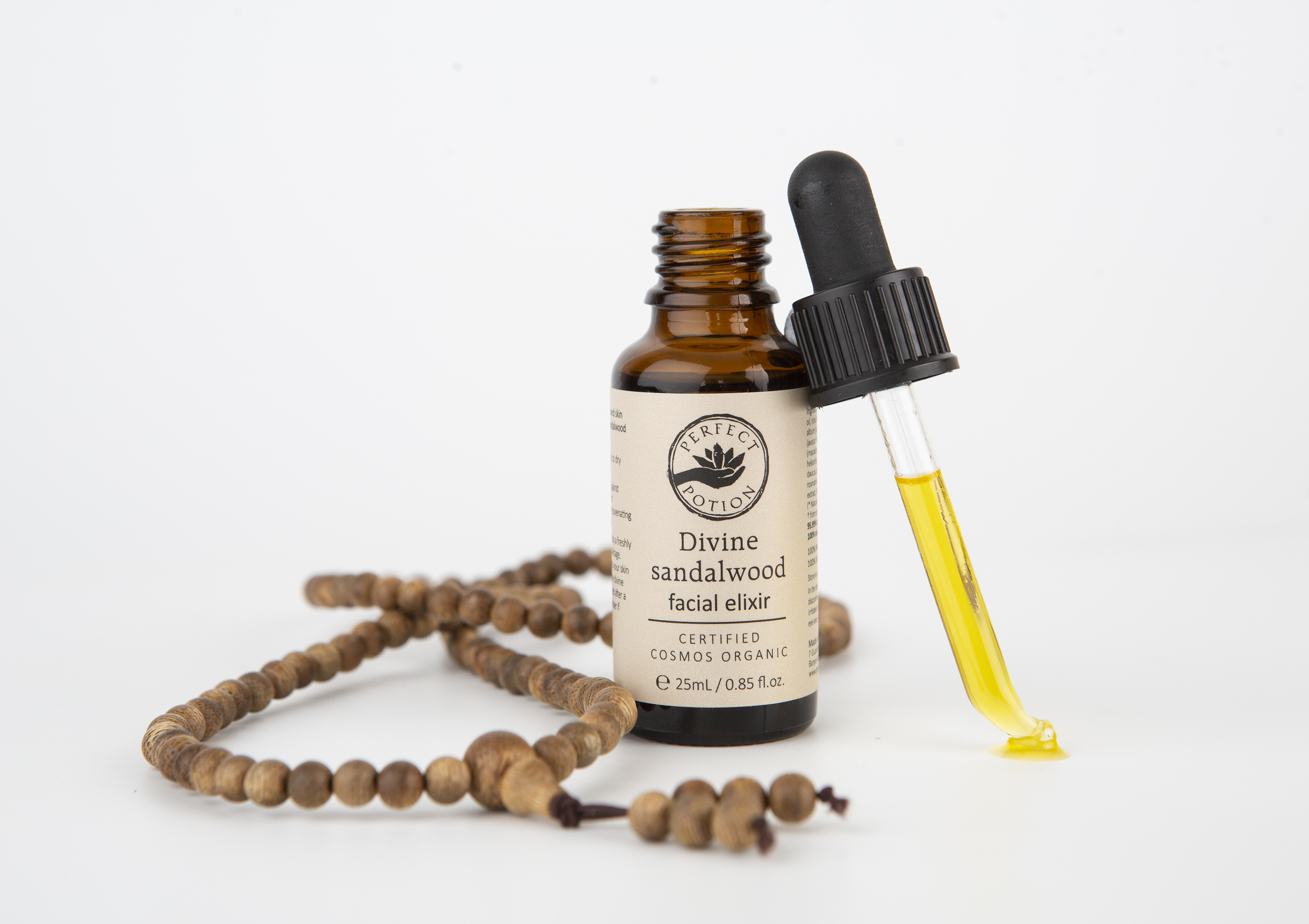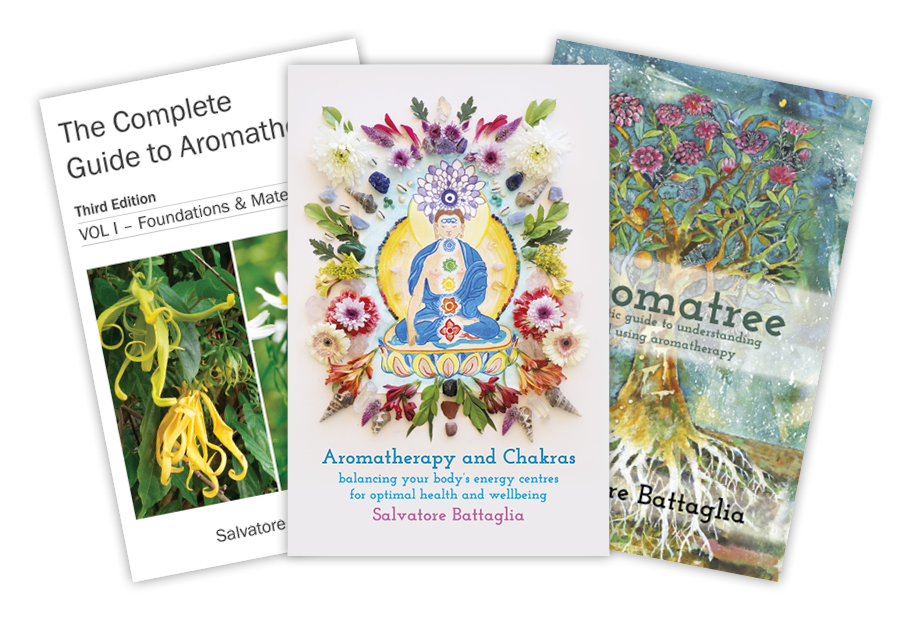Introduction
In traditional aromatherapy, Indian sandalwood, Santalum album, is commonly used in skincare for dry and sensitive skin. The oil is soothing and cooling, and reputed to have anti-inflammatory activity to alleviate eczema, dermatitis and other skin inflammations.1
In traditional Ayurveda, Indian sandalwood has been used for the treatment of colds, burns, headaches, bronchitis, fever, infection of the urinary tract, inflammation of the mouth, liver and gallbladder complaints.
Indian sandalwood is also commonly used as a natural active ingredient in cosmetics and perfumery. The oil has a soft, warm, woody aroma, and is used extensively in perfumery and incense.
Much of the recent research involving Indian sandalwood oil has focused on the oil’s anti-inflammatory, antioxidant, wound healing and anticancer activities. This indicates that Indian sandalwood essential oil is potentially highly beneficial in skincare preparations.
Research examining role of Indian sandalwood in skincare
It has been reported that the therapeutic properties of Indian sandalwood are related to its high content in natural sesquiterpenes, namely α-santalol and β-santalol. While there have been extensive studies examining the oil’s pharmacological activity, the research into the cosmetic attributes of Indian sandalwood have not been extensive.
Antioxidant activity
Recent trends in cosmetics have been aimed at retaining skin health and promoting positive aging of the skin when exposed to pollution, ultraviolet radiation and visible light from the sun and digital screens.2
Recent studies have found that besides UV radiation, other stressors such as High-Energy Visible (HEV) light, or blue light in the 400 – 470nm region of the visible spectrum, as well as environmental pollutants, could trigger biological processes at the skin level which led to premature skin aging.2
One study investigated the protective and anti-aging effects of Indian sandalwood in scavenging reactive oxygen species (ROS) in human skin cells after exposure to oxidative stress.
This study demonstrated that Indian sandalwood oil protected the skin against oxidative stress induced by environmental factors such as blue light, cigarette smoke and ozone. It was further demonstrated that Indian sandalwood oil possessed superior antioxidant activity to vitamin E (alpha-tocopherol).2
Indian sandalwood is reported to have antioxidant, anti-inflammatory, and antiproliferative activities.
It was concluded that Indian sandalwood oil can potentially serve as a protective and anti-aging active ingredient in skincare preparations against environmental stressors.2
Anti-inflammatory activity
A recent study evaluated the anti-inflammatory capacity of Indian sandalwood and its potential to provide some therapeutic benefit to individuals with psoriasis.3
Psoriatic lesions are areas of severe inflammation, with hyperproliferation of keratinocytes that are caused by a pathogenic immune response associated with increased inflammatory responses of the innate and adaptive immune system. The study found that Indian Sandalwood oil supressed cytokine/chemokine production to levels indistinguishable from that found in normal skin models.3
α -santalol has been found to have anti-inflammatory effects by altering the expression of various cytokines and chemokines. It has also been found to supress the arachidonic acid pathway mediated by lipopolysacchides, thereby decreasing prostaglandin E2 and thromboxane B2.4
α -santalol was found to be an inhibitor of tyrosinase, a key enzyme in the biosynthetic pathway of the skin pigment melanin. It was suggested that Indian sandalwood oil may potentially act as an inhibitor of abnormal pigmentation association with aging and exposure to UV light.5
Chemoprotective properties
The anticancer activity of Indian sandalwood essential oil have been extensively reported by Santha & Dwivedi. Experimental evidence indicates that Indian sandalwood oil could function as an inhibitor of tumor initiation and promotion stages of carcinogenesis. Studies in mice indicate the anticarcinogenic activity of sandalwood by enhancing the excretion of carcinogens. Another study found that a 5% topical application of sandalwood oil prevented skin tumour development.6
The anti-cancer activity of Indian sandalwood oil has also been demonstrated in an in vitro study using cultured bladder cancer cells.7
Wound healing properties
Another interesting study found that the olfactory receptor, OR 2AT4, expressed in keratinocytes, has been shown to bind to sandalwood odorants promoting wound healing in human skin ex vivo. These finding indicate that the OR 2AT4 is involved in human keratinocyte re-epithelialization during wound-healing processes.8
One comparative study examined the burn wound healing potential of honey, Indian sandalwood paste, calendula ointment and cooling with water. The results of the study found that honey, Indian sandalwood and calendula as individual agents are effective but less so compared to silver sulfadiazine. However, the honey plus Indian sandalwood combination was the best among all the combination therapies and this combination showed better efficacy than silver sulfadiazine, a pharmaceutical topical antibiotic used to treat burns.9
Skincare blends with Santalum album essential oil
For a range of skin conditions that can be treated with Indian sandalwood oil.
Nourishing dry skin blend
Indian sandalwood essential oil 10 drops
Rose otto 5 drops
Patchouli essential oil 5 drops
Avocado oil 25ml
Macadamia oil 25ml
Sensitive, inflamed skin blend
Indian sandalwood essential oil 10 drops
Lavender essential oil 5 drops
Everlasting essential oil 5 drops
German chamomile essential oil 5 drops
Jojoba oil 25ml
Calendula infused oil 25 ml
Antiaging blend
Indian sandalwood essential oil 10 drops
Carrot seed essential oil 5 drops
Frankincense essential oil 5 drops
Rose absolute 5 drops
Rosehip oil 25ml
Calendula infused oil 25ml
Wound healing blend
Indian sandalwood essential oil 10 drops
Everlasting essential oil 5 drops
Myrrh essential oil 5 drops
Rosehip oil 25ml
Calendula infused oil 25ml
Perfect Potion's New Divine Sandalwood Facial Elixir
Divine Sandalwood Facial Elixir provides an effective shield slowing down environmental damage to and premature aging of the skin, making it feel comfortable, smooth and calm.
Sandalwood is the star of this luxurious, silky facial oil, and is combined with several potent botanical actives to further enhance the skin-beautifying properties of this skincare elixir.
Moisture levels are boosted with oils rich in omega fatty acids; including rosehip, avocado and macadamia oils; to support the skin barrier and promote bouncy, supple and healthy skin. Carrot root extract and tocopherol supply the skin with beta-carotene and vitamin E for glowing, radiant skin.
As you smooth on this precious elixir you will experience the beautiful, delicate, ethereal, sweet, warm, and woody aroma of Santalum album.
DISCOVER PERFECT POTION'S DIVINE SANDALWOOD FACIAL ELIXIR
References
1. Battaglia S. The complete guide to aromatherapy. Volume I – Foundations and Materia Medica. Third Edn, Black Pepper, Brisbane, 2018.
2. Francois-Newton V et al. Antioxidant and anti-aging potential of Indian sandalwood oil against environmental stressors in vitro and ex vivo. Cosmetics. 2021;8:53. doi: 10.3390/cosmetics8020053
3. Sharma M et al. East Indian sandalwood oil alleviates inflammatory and proliferative pathologies of psoriasis. Frontiers in Pharmacology. 2017;8:125. doi:10.3389/fphar.2017.00125
4. Rajsmita B et al. Re-discovering sandalwood: beyond beauty and fragrance. Indian Dermatology Online Journal. 2019;10:296-7
5. Moy RL et al. Sandalwood album oil as a botanical therapeutic in dermatology. Journal of Clinical and Aesthetic Dermatology. 2017;10(10):34-39.
6. Santha S, Dwivedi C. Anticancer effects of sandalwood (Santalum album). Anticancer Research. 2015:35:3137-3146.
7. Dozmorov MG et al. Differential effects of selective frankincense (Ru Xiang) essential oil versus non-selective sandalwood (Tan Xiang) essential oil on cultured bladder cells: a microarray and bioinformatics study. Chinese Medicine. 2014;9:18. Doi: 10.1186/1749-8546-9-18.
8. Busse D et al. A synthetic sandalwood odorant induces wound-healing processes in human keratinocytes via the olfactory receptor OR2AT4. Journal of Investigative Dermatology. 2014;134:2823-2832. doi: 10.1038/jid.2014.273.
9. Dawane JS et al. burn wound healing potential of honey, sandalwood, calendula and cooling with tap water – a comparative study on wistar rats. Journal of Clinical and Diagnostic Research. 2018;12(10):FC10-FC13.



